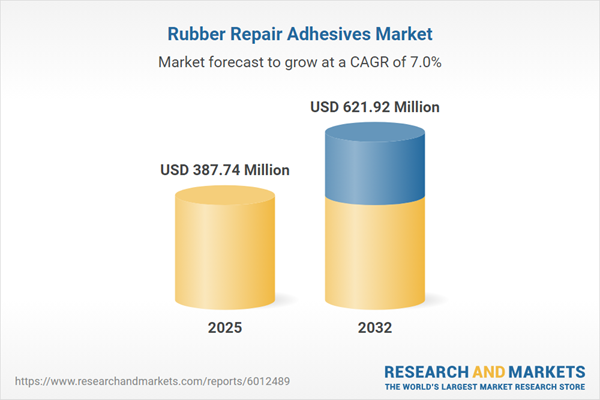Speak directly to the analyst to clarify any post sales queries you may have.
The rubber repair adhesives market is gaining strategic importance for industries seeking enhanced operational resilience and regulatory compliance. As new formulation technologies and evolving supply chain models reshape the competitive landscape, this report equips senior stakeholders with the critical insights needed for confident decision-making.
Market Snapshot: Rubber Repair Adhesives Market Opportunities and Performance
The rubber repair adhesives market grew from USD 362.63 million in 2024 to USD 387.74 million in 2025. It is expected to continue growing at a CAGR of 6.97%, reaching USD 621.92 million by 2032. Expansion reflects rising demand across manufacturing, automotive, construction, and heavy industry sectors as companies prioritize life cycle extensions, maintenance optimization, and adherence to tightening sustainability standards.
Scope & Segmentation
- Product Types: Single part systems (cyanoacrylate, polyurethane, silicone), two part chemistries (acrylic, epoxy, polyurethane)
- Forms: Liquid (solvent based, water based), paste (acrylic, epoxy), tape (cloth, film)
- Applications: Belt splicing (conveyor belt, V belt), hose repair (hydraulic, pneumatic), tyre repair (commercial vehicle, passenger car)
- End-User Industries: Automotive (aftermarket, OEM), construction (commercial, residential), and manufacturing (heavy, light industry)
- Distribution Channels: Online (ecommerce platforms, manufacturer websites), retail (mass merchandisers, specialty stores), wholesale (dealers, distributors)
- Technology Platforms: Cold cure (cyanoacrylate, epoxy), hot melt (pressure sensitive, thermoset), UV cure (acrylate, silicone)
- Regional Coverage: Americas (North America, Latin America), Europe, Middle East & Africa, Asia-Pacific (including major economies like United States, China, India, Germany, and Brazil)
- Leading Companies: Henkel AG & Co. KGaA, 3M Company, Bostik S.A., H.B. Fuller Company, Sika AG, RPM International Inc., Illinois Tool Works Inc., Wacker Chemie AG, Soudal N.V., and Pidilite Industries Limited
Key Takeaways for Senior Decision-Makers
- Emerging sustainability mandates are accelerating demand for water-based, bio-based, and UV-curable adhesives, requiring strategic alignment with evolving environmental regulations.
- Segmented offerings by application, form, and technology enable targeted solutions for high-strength industrial maintenance, emergency repairs, and specialty equipment, reflecting diverse end-user needs.
- Regional variations, especially in Asia-Pacific and EMEA, necessitate agile portfolio management to address market-specific regulatory landscapes and procurement trends.
- Digital transformation—via smart dispensing, real-time monitoring, and predictive maintenance—is driving operational efficiency and supply chain optimization.
- Collaboration with equipment manufacturers, investment in localized production, and adoption of advanced logistics platforms are increasingly critical for supply resilience.
- Customer engagement is shifting, with technical support and training programs supporting adoption of advanced adhesives and reinforcing brand preference.
Tariff Impact: Navigating Trade and Cost Structures
The implementation of additional U.S. trade duties on chemical intermediates and specialty polymers in 2025 has intensified scrutiny of procurement and manufacturing strategies. Companies are shifting toward local and regional sourcing, investing in near-shore facilities, and redesigning formulations to mitigate tariff-related risks. This environment amplifies the importance of adaptable supply networks and cross-functional innovation between R&D and procurement.
Methodology & Data Sources
This report relies on a blend of secondary research from literature, regulatory filings, and technical journals, complemented by primary interviews with key market participants. Data triangulation and iterative expert validation underpin segment analysis, regional trends, and competitive benchmarking.
Why This Report Matters
- Supports strategic planning by highlighting technology trends, regulatory shifts, and evolving end-user preferences across all regions and key segments.
- Enables risk mitigation and margin optimization by examining tariff impacts, supply chain localization, and innovation-driven opportunities.
Conclusion
This research delivers actionable intelligence for organizations navigating a complex, rapidly advancing landscape. Leaders equipped with these insights can confidently drive growth, resilience, and value in the evolving rubber repair adhesives sector.
Additional Product Information:
- Purchase of this report includes 1 year online access with quarterly updates.
- This report can be updated on request. Please contact our Customer Experience team using the Ask a Question widget on our website.
Table of Contents
3. Executive Summary
4. Market Overview
7. Cumulative Impact of Artificial Intelligence 2025
Companies Mentioned
The companies profiled in this Rubber Repair Adhesives market report include:- Henkel AG & Co. KGaA
- 3M Company
- Bostik S.A.
- H.B. Fuller Company
- Sika AG
- RPM International Inc.
- Illinois Tool Works Inc.
- Wacker Chemie AG
- Soudal N.V.
- Pidilite Industries Limited
Table Information
| Report Attribute | Details |
|---|---|
| No. of Pages | 198 |
| Published | October 2025 |
| Forecast Period | 2025 - 2032 |
| Estimated Market Value ( USD | $ 387.74 Million |
| Forecasted Market Value ( USD | $ 621.92 Million |
| Compound Annual Growth Rate | 6.9% |
| Regions Covered | Global |
| No. of Companies Mentioned | 11 |









